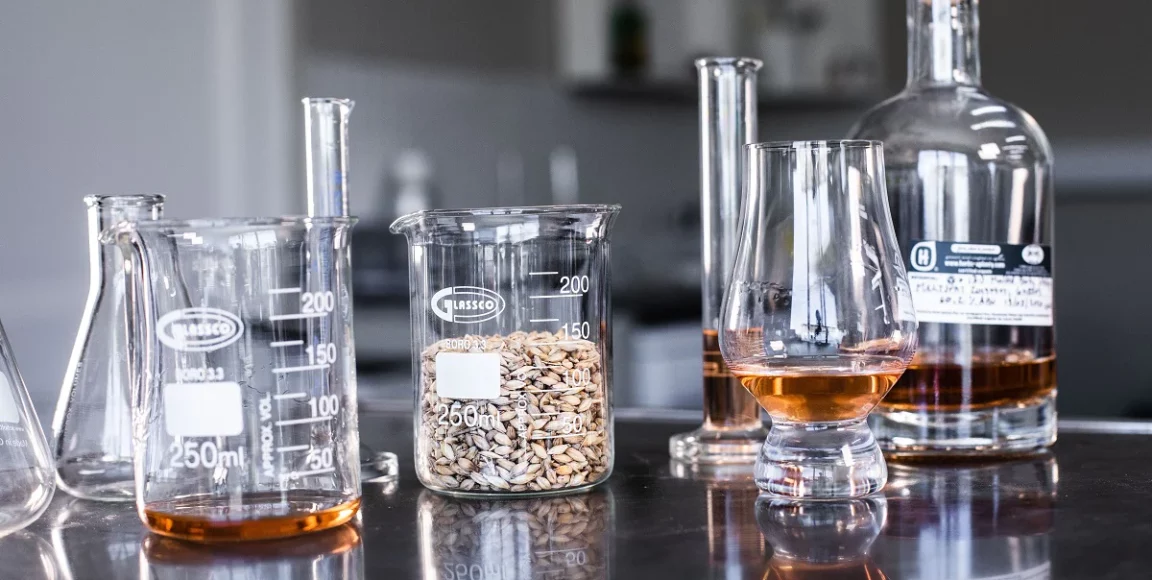Whiskey has been beloved by connoisseurs for centuries. But have you ever stopped to consider the science behind it? Until now, all we knew was that good whiskey should smell and taste great—but what makes it so irresistible? It turns out whiskey is more complex than meets the eye: its flavor and aroma are intimately connected with both biology and chemistry. In this blog post, we’ll explore some of the fundamentals of these two disciplines – from flavor compounds to botanical processes – in order to gain a better understanding of how they shape the unique flavors found in whiskey today.
What is whiskey and how does It differ from other spirits?
Whiskey is a distilled spirit made from grains, such as barley, corn, rye, and wheat. The grains are mashed and fermented in water to produce an alcoholic liquid known as “wash” or “wort.” This wash is then put through a distillation process that involves heating the liquid until it vaporizes, and then collecting the resulting alcohol vapor. This vapor is further distilled into whiskey. The type of grain used affects the flavor of the whiskey – rye will give a spicier flavor while wheat will make it smoother.
What makes whiskey so special?
It’s all about chemistry! Whiskey’s flavor and aroma come from a combination of compounds. These compounds vary depending on the type of whiskey and its production process, but they all provide a unique flavor profile that can’t be found in other types of spirits. The most common compounds found in whiskey are ethanol (alcohol) and volatile organic compounds (VOCs). Ethanol is responsible for the strong taste and smell of whiskey, while VOCs add subtle notes of flavor and aroma.
Biology also plays a role in the flavor and aroma of whiskey. Yeast is used in the fermentation process, which produces esters – compounds that give whiskey its fruity aromas. At the same time, bacteria break down proteins from the grain into amino acids, which contribute to the sweetness and nutty flavors found in some whiskeys.
The three basic ingredients that make a whiskey – grains, water, and yeast
The key ingredients that go into making whiskey are grains, water, and yeast. The grains used will determine the type of whiskey produced – rye for a spicy flavor and wheat for smoother notes. Water is essential to dissolve the sugars from the grains, which then feed the yeast during fermentation. Yeast is responsible for producing ethyl alcohol (ethanol) and carbon dioxide through anaerobic respiration, as well as esters and other compounds that add flavor and aroma to the whiskey.
The maturation process in oak barrels – Giving whiskeys their unique color
Whiskey also undergoes a maturation process in oak barrels that gives it its unique taste and color. As whiskey matures in oak barrels, oxygen gets absorbed by wood particles, which then interact with the alcohol to create new compounds that give whiskey its characteristic flavor and color. This aging process also breaks down tannins from the wood, making the whiskey smoother and mellower.
The role of maturation in achieving the perfect flavor profile
Maturation can be defined as the process of aging a whiskey in oak barrels. To achieve the perfect flavor profile, distillers must consider factors like barrel size, char level, and length of maturation. By experimenting with these elements – as well as blending different types of whiskey together – distillers can create unique and complex whiskeys that delight even the most discerning connoisseur.
Aging – A key factor in the development of complexity and richness
Aging can be defined as the process of allowing whiskey to mature for a certain amount of time. Aging in oak barrels has two main effects – it gives whiskey its unique flavor and color, and it also increases its complexity and richness. By aging an already good whiskey for longer, distillers can create a marvelous spirit that is smooth, complex, and truly exceptional.
How to buy whiskies online
When shopping for whiskies, it can be difficult to know where to buy them from. Fortunately, you can buy whiskies online from a variety of retailers and specialty stores. Before buying whiskey online, do some research on the retailer’s reputation as well as the type of whiskey you’re looking for. Many websites provide detailed reviews of different whiskeys so you can get an idea of which one best suits your taste. Once you’ve found a few preferred options, compare prices between different retailers and buy the one that offers the best value for your money. Buying whiskey online is a great way to find rare or hard-to-find bottles at affordable prices!
At Top Whiskies, we believe that everyone should have access to quality whiskeys at affordable prices. With our easy-to-use search feature and detailed reviews, it’s never been easier to buy great whiskies online! So if you’re looking for unique bottles of whiskey or just want to buy a gift for a whisky lover, look no further than Top Whiskies. We’re sure you’ll find something that suits your taste!
No matter if you are a beginner or an experienced connoisseur, buy whiskies online at Top Whiskies and let us help you find the perfect bottle for any occasion. Our collection includes bottles from around the world and we offer unbeatable prices on all our products so you can buy the best whiskeys without breaking the bank. So what are you waiting for? Head over to Top Whiskies now and start exploring our selection of premium whiskeys!
Conclusion
The science of whiskey is an incredibly complex and fascinating subject, demonstrating the delicate balance between chemistry, biology, and flavor. It’s an art form steeped in centuries of history and tradition, yet one which continues to evolve as we learn more about its chemistry and biology. For anyone interested in whiskey – whether you are an experienced medicine maker, an amateur home distiller, or just a lover of great taste – understanding these nuances is key to unlocking the amazing flavors on offer. By exploring the intricate links between distillation processes and chemical compositions, we can appreciate whiskey like never before; from its subtle smoky notes to its prominent sweet fruits and everything in between. With knowledge comes appreciation – a deeper understanding of what lies at the heart of this beloved spirit.



